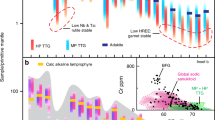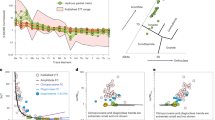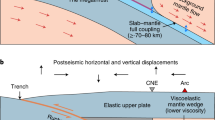Abstract
Some of Earth's coldest mantle is found in subduction zones at the tip of the mantle wedge that lies between the subducting and overriding plates. This forearc mantle is isolated from the flow of hot material beneath the volcanic arc, and so is inferred to reach temperatures no more than 600 to 800 °C — conditions at which hydrous mantle minerals should be stable. The forearc mantle could therefore constitute a significant reservoir for water if sufficient water is released from the subducting slab into the mantle wedge. Such a reservoir could hydrate the plate interface and has been invoked to aid the genesis of megathrust earthquakes and slow slip events. Our synthesis of results from thermal models that simulate the conditions for subduction zones globally, however, indicates that dehydration of subducting plates is too slow over the life span of a typical subduction zone to hydrate the forearc mantle. Hot subduction zones, where slabs dehydrate rapidly, are an exception. The hottest, most buoyant forearcs are most likely to survive plate collisions and be exhumed to the surface, so probably dominate the metamorphic rock record. Analysis of global seismic data confirms the generally dry nature of mantle forearcs. We conclude that many subduction zones probably liberate insufficient water to hydrate the shallower plate boundary where great earthquakes and slow slip events nucleate. Thus, we suggest that it is solid-state processes and not hydration that leads to weakening of the plate interface in cold subduction zones.
This is a preview of subscription content, access via your institution
Access options
Access Nature and 54 other Nature Portfolio journals
Get Nature+, our best-value online-access subscription
$29.99 / 30 days
cancel any time
Subscribe to this journal
Receive 12 print issues and online access
$259.00 per year
only $21.58 per issue
Buy this article
- Purchase on Springer Link
- Instant access to full article PDF
Prices may be subject to local taxes which are calculated during checkout




Similar content being viewed by others
References
Grove, T. L., Till, C. B. & Krawczynski, M. J. The role of H2O in subduction zone magmatism. Annu. Rev. Earth Planet. Sci. 40, 413–439 (2012).
Abers, G. A., van Keken, P. E., Kneller, E. A., Ferris, A. & Stachnik, J. C. The thermal structure of subduction zones constrained by seismic imaging: implications for slab dehydration and wedge flow. Earth Planet. Sci. Lett. 241, 387–397 (2006).
Wada, I. & Wang, K. Common depth of slab-mantle decoupling: reconciling diversity and uniformity of subduction zones. Geochem. Geophys. Geosyst. 10, Q10009 (2009).
Syracuse, E. M., van Keken, P. E. & Abers, G. A. The global range of subduction zone thermal models. Phys. Earth Planet. Int. 183, 73–90 (2010).
Reynard, B. Serpentine in active subduction zones. Lithos 178, 171–185 (2013).
van Keken, P. E., Hacker, B. R., Syracuse, E. M. & Abers, G. A. Subduction factory 4: depth-dependent flux of H2O from subducting slabs worldwide. J. Geophys. Res. 116, B01401 (2011).
Hacker, B. R. H2O subduction beyond arcs. Geochem. Geophys. Geosyst. 9, Q03001 (2008).
Workman, R. K. & Hart, S. R. Major and trace element composition of the depleted MORB mantle (DMM). Earth Planet. Sci. Lett. 231, 53–72 (2005).
Connolly, J. A. D. Computation of phase equilibria by linear programming: a tool for geodynamic modeling and its application to subduction zone decarbonation. Earth Planet. Sci. Lett. 236, 524–541 (2005).
Saffer, D. M. & Tobin, H. J. Hydrogeology and mechanics of subduction zone forearcs: fluid flow and pore pressure. Annu. Rev. Earth Planet. Sci. 39, 157–186 (2011).
Jarrard, R. D. Subduction fluxes of water, carbon dioxide, chlorine and potassium. Geochem. Geophys. Geosyst. 4, GC000392 (2003).
Fryer, P., Wheat, C. G. & Mottl, M. J. Mariana blueschist mud volcanism: implications for conditions within the subduction zone. Geology 27, 103–106 (1999).
Syracuse, E. M. & Abers, G. A. Global compilation of variations in slab depth beneath arc volcanoes and implications. Geochem. Geophys. Geosyst. 7, Q05017 (2006).
Jicha, B. R., Scholl, D. W., Singer, B. S., Yogodzinski, G. M. & Kay, S. M. Revised age of Aleutian island arc formation implies high rate of magma production. Geology 34, 661–664 (2006).
Reagan, M. K. et al. Fore-arc basalts and subduction initiation in the Izu–Bonin–Mariana system. Geochem. Geophys. Geosyst. 11, GC002871 (2010).
Wells, R. et al. Geologic history of Siletzia, a large igneous province in the Oregon and Washington Coast Range: correlation to the geomagnetic polarity time scale and implications for a long-lived Yellowstone hotspot. Geosphere 10, 692–719 (2014).
Hall, R. Cenozoic geological and plate tectonic evolution of SE Asia and the SW Pacific: computer-based reconstructions, model and animations. J. Asian Earth Sci. 20, 353–431 (2002).
Clift, P. & Vannucchi, P. Controls on tectonic accretion versus erosion in subduction zones: implications for the origin and recycling of the continental crust. Rev. Geophys. 42, RG2001 (2004).
Wilson, C. R., Spiegelman, M., van Keken, P. E. & Hacker, B. R. Fluid flow in subduction zones: the role of solid rheology and compaction pressure. Earth Planet. Sci. Lett. 401, 261–274 (2014).
Cozzens, B. D. & Spinelli, G. A. A wider seismogenic zone at Cascadia due to fluid circulation in subducting oceanic crust. Geology 40, 899–902 (2012).
Penniston-Dorland, S. C., Kohn, M. J. & Manning, C. E. The global range of subduction zone thermal structures from exhumed blueschists and eclogites: rocks are hotter than models. Earth Planet. Sci. Lett. 428, 243–254 (2015).
Spandler, C. & Pirard, C. Element recycling from subducting slabs to arc crust: a review. Lithos 170–171, 208–223 (2013).
Abers, G. A. & Hacker, B. R. A MATLAB toolbox and Excel workbook for calculating the densities, seismic wave speeds, and major element composition of minerals and rocks at pressure and temperature. Geochem. Geophys. Geosyst. 17, GC006171 (2016).
Brownlee, S. J., Hacker, B. R., Harlow, G. E. & Seward, G. Seismic signatures of a hydrated mantle wedge from antigorite crystal-preferred orientation (CPO). Earth Planet. Sci. Lett. 375, 395–407 (2013).
Yang, X., Fischer, K. M. & Abers, G. A. Seismic anisotropy beneath the Shumagin Islands segment of the Aleutian-Alaska subduction zone. J. Geophys. Res. 100, 18165–118177 (1995).
Nakajima, J. & Hasegawa, A. Shear-wave polarization anisotropy and subduction-induced flow in the mantle wedge of northeastern Japan. Earth Planet. Sci. Lett. 225, 365–377 (2004).
Korenaga, J. On the extent of mantle hydration caused by plate bending. Earth Planet. Sci. Lett. 457, 1–9 (2017).
Bostock, M. G., Hyndman, R. D., Rondenay, S. & Peacock, S. M. An inverted continental Moho and serpentinization of the forearc mantle. Nature 417, 536–538 (2002).
Brocher, T. M., Parsons, T., Trehu, A. M., Snelson, C. M. & Fisher, M. A. Seismic evidence for widespread serpentinized forearc upper mantle along the Cascadia margin. Geology 31, 267–270 (2003).
DeShon, H. et al. Seismogenic zone structure beneath the Nicoya Peninsula, Costa Rica, from three-dimensional local earthquake P- and S-wave tomography. Geophys. J. Int. 164, 109–124 (2006).
Kay, R. W. & Kay, S. M. Delamination and delamination magmatism. Tectonophysics 219, 177–189 (1993).
Hacker, B. R., Kelemen, P. B. & Behn, M. D. Continental lower crust. Annu. Rev. Earth Planet. Sci. 43, 167–205 (2015).
Liu, Y. J. & Rice, J. R. Spontaneous and triggered aseismic deformation transients in a subduction fault model. J. Geophys. Res. 112, JB004930 (2007).
Audet, P., Bostock, M. G., Christensen, N. I. & Peacock, S. M. Seismic evidence for overpressured subducted oceanic crust and sealing of the megathrust. Nature 457, 76–78 (2009).
Leeman, J., Saffer, D., Scuderi, M. & Marone, C. Laboratory observations of slow earthquakes and the spectrum of tectonic fault slip modes. Nat. Commun. 7, 11104 (2016).
Guillot, S., Hattori, K. H. & de Sigoyer, J. Mantle wedge serpentinization and exhumation of eclogites: insights from eastern Ladakh, northwest Himalaya. Geology 28, 199–202 (2000).
Schwartz, S., Allemand, P. & Guillot, S. Numerical model of the effect of serpentinites on the exhumation of eclogitic rocks: insights from the Monviso ophiolitic massif (Western Alps). Tectonophysics 342, 193–206 (2001).
Hacker, B. R., Kelemen, P. B. & Behn, M. D. Differentiation of the continental crust by relamination. Earth Planet. Sci. Lett. 307, 501–516 (2011).
Acknowledgements
This work is funded by NSF awards OCE-1446970 to GAA, OCE-1249353 and OCE-1356132 to P.E.v.K., and EAR-1249703 to B.R.H.
Author information
Authors and Affiliations
Contributions
GA compiled and analysed seismic data, P.E.v.K. oversaw geodynamic modelling, B.R.H. oversaw petrology and thermodynamic modelling. All of the authors contributed to discussion and writing of the manuscript.
Corresponding author
Ethics declarations
Competing interests
The authors declare no competing financial interests.
Supplementary information
Supplementary Discussions, Tables and Figures
Supplementary information Discussions 1–4, Tables 1–4 and Figures 1–2 (PDF 1571 kb)
Rights and permissions
About this article
Cite this article
Abers, G., van Keken, P. & Hacker, B. The cold and relatively dry nature of mantle forearcs in subduction zones. Nature Geosci 10, 333–337 (2017). https://doi.org/10.1038/ngeo2922
Received:
Accepted:
Published:
Issue Date:
DOI: https://doi.org/10.1038/ngeo2922
This article is cited by
-
An introductory review of the thermal structure of subduction zones: I—motivation and selected examples
Progress in Earth and Planetary Science (2023)
-
Understanding subduction infancy to mature subduction in Southwest Japan via the self-consistent formation of a weak slab interface
Scientific Reports (2023)
-
Heterogeneous slab thermal dehydration driving warm subduction zone earthquakes
Scientific Reports (2023)
-
A possible mechanism for spontaneous cyclic back-arc spreading
Progress in Earth and Planetary Science (2022)
-
An explosive component in a December 2020 Milan earthquake suggests outgassing of deeply recycled carbon
Communications Earth & Environment (2022)



